Fellow Award: Revisited (Again)
Robert Starbuck, Committee on Fellows Member
The 2010 ASA Fellow awards were presented at the Joint Statistical Meetings in Vancouver, British Columbia, earlier this month. Here, I present a brief update to previous articles on this subject appearing in Amstat News. A few corrections have been made to previous counts of Fellow nominees and awardees.
Employment Sector
In the range of years shown, the percentages of ASA members by employment sector have remained relatively stable: 42% academe, 47% business/industry, 11% government.
The counts of ASA Fellow awards given by employment sector since 2004 are presented in Table 1 and Figure 1.
Table 1—Counts and Percentages of ASA Fellow Awards
Figure 1. Percentages of ASA Fellows awarded by employment sector
The percentages of Fellows awarded by employment sector relative to the percentages of ASA membership by sector are shown in Figure 2.
Figure 2. Percentages of ASA Fellows awarded/percentages of ASA membership by employment sector
The counts and percentages of Fellow nominations by employment sector are shown in Table 2. The number of nominations from business/industry was lower this year than in any of the seven years included in this report.
Table 2—Counts and Percentages of ASA Fellows Nominations
So, how have the nominations fared in each of the employment sectors? As shown in Table 3 and Figure 3, nominations submitted this year from the business/industry and government sectors did not fare well and were far less successful than nominations from academe.
Table 3—Percentages of Successful ASA Fellows Nominations
Figure 3. Percentages of successful ASA Fellows nominations by employment sector
Gender
The membership of the ASA has changed significantly in the percentages of females and males, as illustrated in Table 4 and Figure 4. This table looks at the current ASA membership and subsets that joined the ASA in ranges of previous years.
Table 4—Percentages of ASA Membership by Gender
Figure 4. Percentages of current ASA members by gender
Assuming the number of departures from the ASA membership has been proportional to gender (i.e., females and males are equally likely to discontinue or retain ASA membership), there has been a noticeable increase in the percentage of female members.
The ASA Fellow award is almost always given to ASA members who have reached mid-career, and, as such, the gender percentages of ASA membership that are appropriate reference points for 2004–2010 are those reflecting members who joined the ASA on or before 1994–1999. Thus, the relevant reference percentages for females for Fellow nominations and awards are in the 21% to 23% range.
The counts and percentages by gender of ASA Fellow nominations in 2004–2009 are presented in Table 5.
The percentages of female nominees have been slightly below the reference percentages for four of the seven years, and were substantially below in 2009.
Table 5—Counts and Percentages of ASA Fellow Nominations by Gender
The counts and percentages by gender of ASA Fellow awards in 2004–2010 are presented in Table 6, and the percentages are presented in Figure 5.
Table 6—Counts and Percentages of ASA Fellow Awards by Gender
Figure 5. Percentages of ASA Fellows awarded by gender
The percentages of female Fellow awardees have been generally reflective of the reference percentages. As shown in Table 7 and Figure 6, the decline in the percentage of female Fellow awardees in 2009 was due to the lower percentage of female Fellow nominations. For nominees, the average chance of success is slightly higher for females.
Table 7—Percentages of Successful ASA Fellow Nominations by Gender
Figure 6. Percentages of successful ASA Fellows nominations by gender
Conclusion
The number of Fellow nominations from a given employment sector or gender is a key factor in determining the number of awards from that sector. The other obvious key factor is the quality of the nominations. To increase the number of Fellow awards in an employment sector or gender to achieve parity in the percentages of awards relative to the percentages of ASA membership (see figures 2 and 5), the number of nominations from that sector or gender needs to increase, and these nominations need to be of good quality.
The ASA Fellow award is a significant recognition of contributions to the statistics profession and one that should reflect the constituency of the membership of the ASA. If you or others you know are deserving of this award, please participate in and encourage others to participate in the award nomination process.

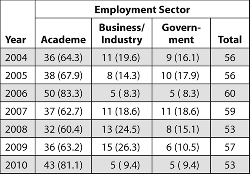
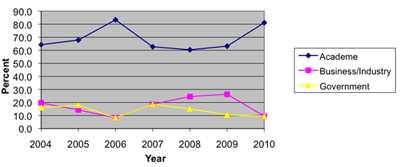
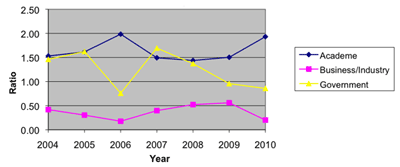
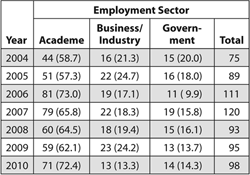
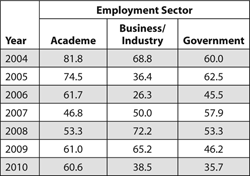
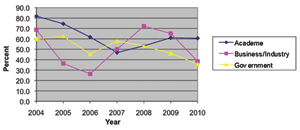
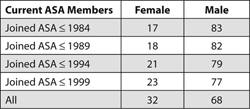
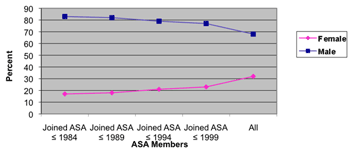
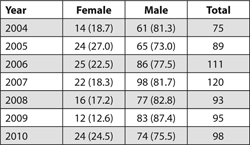
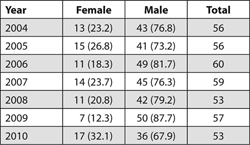
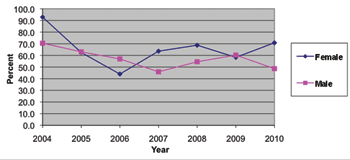

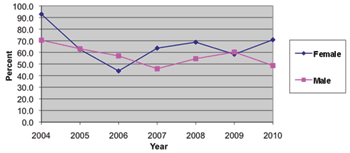









Please look at Table 7:
Consistantly, the success rate as measured by percent for women is higher than that for men. What does that say about evaluation process? Certainly, it is not a statistical anamoly. Are we harsher when it comes to evaluating men? Political accommodation or Reverse discrimination?
One possible explanation for why there aren’t enough nominations among business/industry statisticians is that you cannot nominate yourself for the Fellows Award. I believe that more ASA members in Business/Industry are likely to find themselves as “isolated statisticians” compared to academia and government. They have to find someone outside of their workplace to nominate them, which is something of an imposition.
Perhaps the committee should consider self-nomination for the Fellows Award to encourage more applicants in Business/Industry.
Steve Simon
Welcome!
Amstat News is the monthly membership magazine of the American Statistical Association, bringing you news and notices of the ASA, its chapters, its sections, and its members. Other departments in the magazine include announcements and news of upcoming meetings, continuing education courses, and statistics awards.
ASA HOME
Departments
Archives
ADVERTISERS
PROFESSIONAL OPPORTUNITIES
FDA
US Census Bureau
Software
STATA
QUOTABLE
“ My ASA friendships and partnerships are some of my most treasured, especially because the ASA has enabled me to work across many institutional boundaries and
with colleagues from many types of organizations.”
— Mark Daniel Ward
Editorial Staff
Managing Editor
Megan Murphy
Graphic Designers / Production Coordinators
Olivia Brown
Meg Ruyle
Communications Strategist
Val Nirala
Advertising Manager
Christina Bonner
Contributing Staff Members
Kim Gilliam